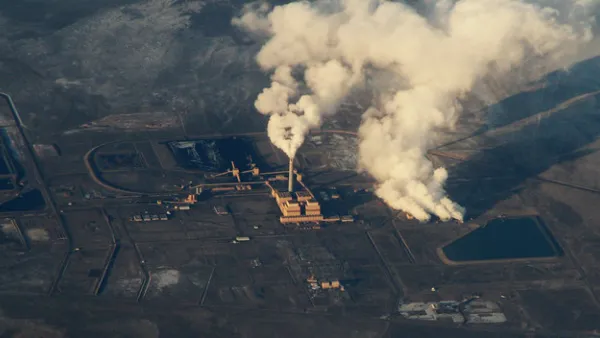On Tuesday night, the City Council of Berkeley, Calif., unanimously voted to ban natural gas infrastructure from new buildings starting next year, the first city in the U.S. to pass such an ordinance. Fifty cities in the state could be next.

"It’s not the first time Berkeley has passed pioneering health or environmental legislation," reports
In 1977, Berkeley was the first in the country to ban smoking in restaurants and bars. In January the city banned single-use disposables, requiring restaurants to use to-go foodware that is compostable.
After its passage, Councilmember Kate Harrison, who introduced the ordinance, "thanked the community and her colleagues 'for making Berkeley the first city in California and the United States to prohibit natural gas infrastructure in new buildings',” adds Ravani.
“It’s an enormous issue,” Harrison told The Chronicle. “We need to really tackle this. When we think about pollution and climate-change issues, we tend to think about factories and cars, but all buildings are producing greenhouse gas.”
According to the agenda background information prepared by city staff (page 59 of 334 in July 16 agenda [Dropbox pdf]), "natural gas is a leading source of green-house gas emissions (GHGs) in Berkeley, responsible for 27% of the GHGs released in the city [in 2016]. The only source sector with more local GHG emissions is the transportation sector."
California Energy Commission Chairman David Hochschild, a Berkeley resident who also spoke at the meeting, stated that "there are more emissions coming from combustion natural gas in our buildings than our entire state power plant fleet.” According to the 2016 state greenhouse gas emission inventory, electricity is responsible for 16 percent of GHGs, the third largest after transportation at 41 percent and industry at 23 percent. Hochschild added that "50 cities across the state, including San Francisco, are considering similar action."
"According to the 2018 Integrated Energy Policy Report by the California Energy Commission, building electrification is the lowest-cost and lowest-risk pathway to achieving deep decarbonization of buildings in California," wrote Pierre Delforge, a senior scientist with the Natural Resources Defense Council.
"Public support was also unanimous during 45 minutes of comment from community members and representatives of the University of California’s Office of the President, energy giant PG&E and the Sierra Club, among others who spoke," reports Emilie Raguso for Berkeleyside.
Not just about GHGs
The Sierra Club's San Francisco Bay Chapter emphasized the health aspect of building electrification.
Berkeley's gas phase out isn't just a good move against the climate crisis; it's also good for public health. Homes with gas appliances not only have high levels of indoor air pollution but have also been linked to increased rates of childhood asthma. By phasing out gas in new buildings, Berkeley moves to protect the health of its current and future residents.
Indeed, according to NRDC's Delforge, "Gas burned in buildings, primarily for heating and hot water, produces more greenhouse gases (GHGs), and eight times more nitrogen oxide pollution (NOx), than all the state’s power plants."
Heat pumps and induction cooking
"Instead of having natural gas pipes, electric-only buildings install heat pumps and induction cooking, said Ben Gould, the chairman of Berkeley’s Community Environmental Advisory Commission," adds Ravani. As for additional costs incurred by the ordinance, it's possible cities could get help from the state thanks to the passage last year of Senate Bill 1477 by Senator Henry Stern (D-Canoga Park), which "allocates $50 million each year until 2023 from utility cap-and-trade auctions revenue to support two programs," according to Delforge.
"PG&E owns a 9,000-square-foot commercial kitchen in San Ramon that has all induction appliances, which company officials show developers and restaurateurs as proof that it can be done," reports Ali Tadayon for The Mercury News.
Exemptions
"The ordinance has a few temporary exemptions for building systems that cannot currently be modeled in the California building code compliance software, like central hot water systems in large apartment buildings and hotels," wrote NRDC's Delforge.
"The new ordinance includes exemptions for internal accessory dwelling units (those that are built inside an existing home) as well as projects that the city’s Zoning Adjustments Board or planning staff determine are in the public interest," adds Berkeleyside's Raguso.
Not all on board
While no one spoke against the ordinance at the Berkeley meeting, KQED Forum, a program of the Bay Area's NPR affiliate, held a half-hour panel discussion and call-in on Thursday that included representatives from the Building Decarbonization Coalition, composed of builders, energy providers, and environmental organizations supporting building electrification, and the Californians for Balanced Energy Solutions, a coalition of natural and renewable gas users, that featured a lively debate on the ordinance and the merits of banning natural gas infrastructure from new buildings.
Help wanted
"The ordinance allocates $273,341 per year for a two-year staff position in the Building and Safety Division within the city’s Department of Planning and Development. The employee will be responsible for implementing the ban," adds Ravani.
Additional reading:
- Clean Technica: This Is How Natural Gas Loses: One Building At A Time, July 18th, 2019
- Bloomberg News: Berkeley Is the First City in America to Ban Gas From New Homes, July 17, 2019
- New York Times opinion: Your Gas Stove Is Bad for You and the Planet, May 1, 2019
Related in Planetizen:
-
California's Push to Electrify Its Building Stock, March 1, 2019
-
Taking the Carbon Emissions Out of Buildings, February 19, 2019
-
Could the Humble Heat Pump Be a Decarbonization Hero? September 18, 2017
FULL STORY: Berkeley becomes first U.S. city to ban natural gas in new homes

National Parks Layoffs Will Cause Communities to Lose Billions
Thousands of essential park workers were laid off this week, just before the busy spring break season.

Retro-silient?: America’s First “Eco-burb,” The Woodlands Turns 50
A master-planned community north of Houston offers lessons on green infrastructure and resilient design, but falls short of its founder’s lofty affordability and walkability goals.

Delivering for America Plan Will Downgrade Mail Service in at Least 49.5 Percent of Zip Codes
Republican and Democrat lawmakers criticize the plan for its disproportionate negative impact on rural communities.

Test News Post 1
This is a summary

Test News Headline 46
Test for the image on the front page.

Balancing Bombs and Butterflies: How the National Guard Protects a Rare Species
The National Guard at Fort Indiantown Gap uses GIS technology and land management strategies to balance military training with conservation efforts, ensuring the survival of the rare eastern regal fritillary butterfly.
Urban Design for Planners 1: Software Tools
This six-course series explores essential urban design concepts using open source software and equips planners with the tools they need to participate fully in the urban design process.
Planning for Universal Design
Learn the tools for implementing Universal Design in planning regulations.
EMC Planning Group, Inc.
Planetizen
Planetizen
Mpact (formerly Rail~Volution)
Great Falls Development Authority, Inc.
HUDs Office of Policy Development and Research
NYU Wagner Graduate School of Public Service





























